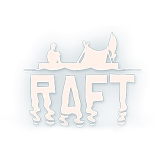
|
Engine | ||||||
|---|---|---|---|---|---|---|---|
| Requires: | |||||||
Stacksize |
5 | ||||||
Type |
Navigation | ||||||
Engine is a Navigation item in Raft.
Summary
The Engine is acquired through the Blueprint: Engine found on the Vasagatan. After researching the blueprint, players may build and place an engine in order to sail against the wind. Used in combination with the Steering Wheel, the player gets full control of which direction they wish to sail. One Engine can push a raft of up to 100 Foundations. For each set of 100 Foundations over the initial 100, another Engine must be built and run simultaneously in order for them to have enough power to sail the raft. Note that Collection Nets do not count towards number of Foundations.
Adding six Engines to a raft will increase the sailing speed to the maximum possible, while ignoring aforementioned Foundation limitations, allowing you to sail any raft with over 600 foundations.
There is a useful FAQ link titled "Do multiple engines make the raft faster?" here.
Uses
- Place on the raft and turn on to sail in a desired direction.
- Use with a Steering Wheel to fully control direction.
- Can be painted any colour with the
 Paint Brush.
Paint Brush.
Fuel
The Engine runs on Planks or Biofuel, and a full tank lasts for 10 minutes. Each plank fuels an Engine for 36 seconds, meaning a tank can fit 17 planks rounded up (if the last plank is added too soon, some fuel will be wasted). A single canister of Biofuel can power an Engine for 12 minutes (the equivalent of 20 planks), but because that exceeds the capacity of the Engine's tank, inserting the canister directly into the Engine would waste at least 2 minutes of fuel. Biofuel can be more efficiently stored in Biofuel Tanks and then supplied to the Engine through Fuel Pipes to extend the time between having to refuel. A Biofuel Tank can be filled with four Biofuel canisters and powers a single Engine for a total of 48 minutes (approximately 2.4 to 3.6 in-game days depending on whether or not the player sleeps).
Stuttering
If the Engine is unable to push the Raft, whether if it's anchored or overburdened, it will slow down to a stop while simultaneously stuttering indicating something is wrong. No fuel is used during this time, despite the Engine being on.
Following is a comparison of the running and stuttering Engine:
If an Engine is not working properly, it can be caused by the following:
- Too many Foundations. An Engine can push up to 100 foundations. Make sure that the amount of Engines covers the amount of Foundations.
- The raft is anchored. Make sure no anchors are currently holding the raft in place.
- One or more Engines lacks fuel. Check fuel level on all Engines.
- The Engines are going in opposite directions. Check the Engine direction lever and make sure they match.
Speed
The speed of the Raft is calculated by the number of engines and the number of foundations. By adding more engines to the raft, the theoretical speed is greater (every engine adds the value 2); because there is a hard cap, the speed will never exceed a cap of 2.5 and drop below the lower limit of 1.5. Only if the engines are overburdened the speed will be zero.
The engines become overburdened if a limit of 110 foundations per engine is exceeded.
There is a second limit of 100 per engine, over which the engines will be in a slow modus ("Slow Zone") in which they only use 50% of their power, but because of the way it is implemented this is only relevant on a raft with 1 or 2 engines, but not on a raft with 3 or more engines.
These rules[1] can be described as follows:
E = Number of Engines F = Number of Foundations OF [Overburdened-Factor] = IF(F > E*110; 0; 1) [0 or 1] SF [Slow Zone-Factor] = IF(F > E*100; 0.5; 1) [0.5 or 1] TS [Theoretical Speed] = E*2 * SF [1 to no upper limit] RS [Resulting Speed] = OF * (MAX(1.5; MIN(2.5; TS)) [0 or between 1.5 and 2.5]
By applying those rules to different combinations of parameters there are the following possibilities for the resulting speed (RS):
| F (Foundations) | E (Engines) | |||
|---|---|---|---|---|
| 1 | 2 | 3 | 4+ | |
| 1-100 | 2.0 | 2.5 | 2.5 | 2.5 |
| 101-110 | 1.5 | |||
| 111-200 | 0.0 | |||
| 201-220 | 2.0 | |||
| 221-330 | 0.0 | |||
| 331-(E*110) | 0.0 | |||
| (E*110)+1 | 0.0 | |||
There are basically three possible Engine speeds in Raft, disregarding drifting. Slow sailing (1.5), when a single Engine can push the raft but at minimum speed before stopping completely. Medium speed (2.0), achieved by using a single Engine on a raft under 100 foundations, or by using 2 Engines in the 'Slow Zone' (201-220 Foundations). High speed (2.5), when a raft has multiple Engines which are successfully sailing the raft. Since Engine speed is additive when running multiple Engines at the same time, high speed is always achieved once the raft is successfully sailing with at least 3 engines, but not if the raft is overburdened.
History
| Early Access | |||||
|---|---|---|---|---|---|
| Update 10.03 | Added a message, which shows how many foundations it can carry. | ||||
| Update 10 | Engine was added to the game. | ||||

